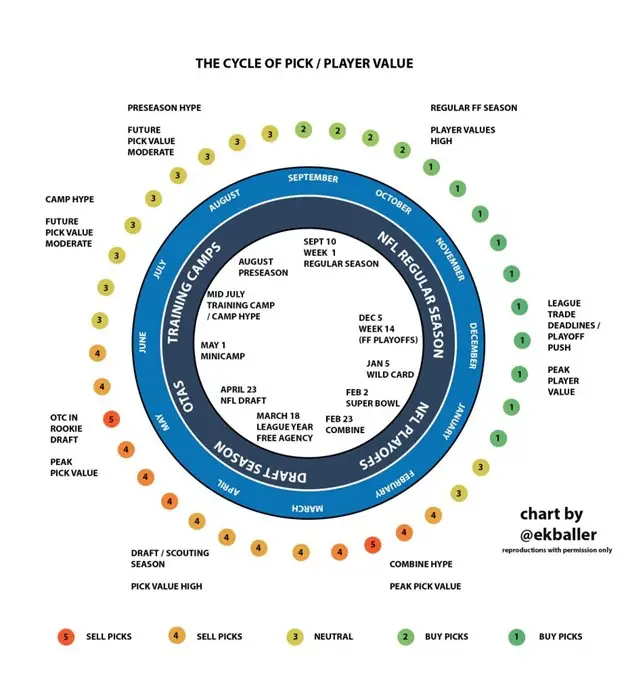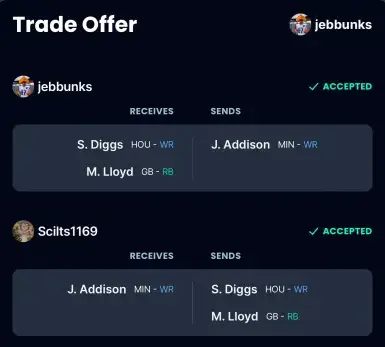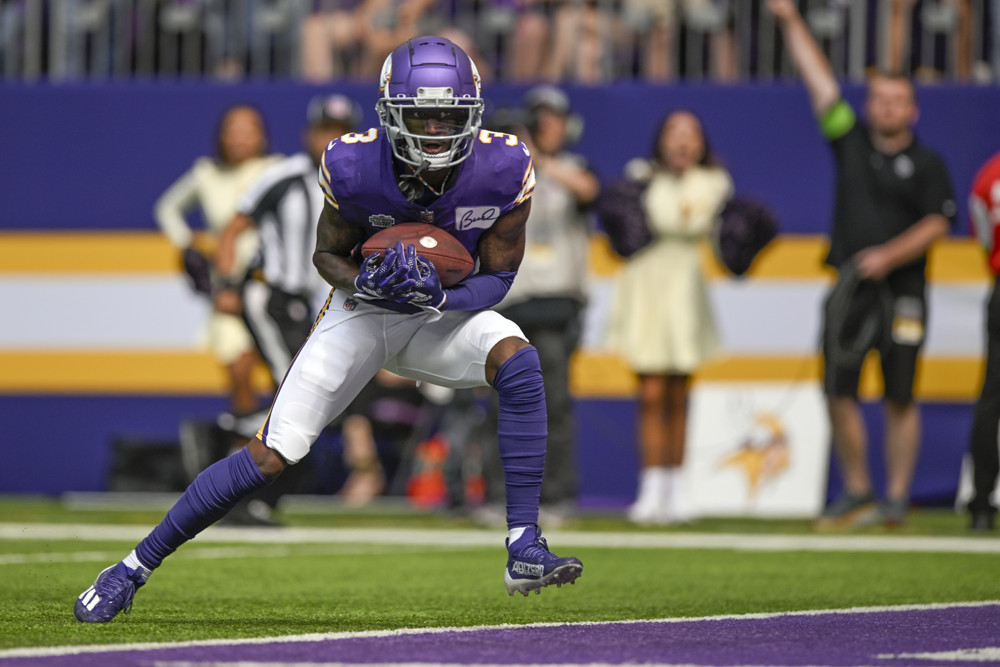Like a tree losing its leaves in the fall, preparing for winter, or the spring flowers waiting to bloom, you notice one thing: the seasons are changing. And just like weather signals the changing seasons, there too are seasons and cycles to dynasty fantasy football. It might sound obvious, but there are certain times of the fantasy football season where your league mates will value older players in a push to win a fantasy championship. However, on the flip side, as soon as that trophy has been lifted, the focus immediately shifts to the off-season. We look forward to the NFL draft, where everyone wants to get a piece of the new incoming NFL rookie class.
How to take advantage of knowing the dynasty trading lifecycle
There is a wonderful chart created by our very own @ekballer in his article “How to Play Dynasty Fantasy Football – Vol 3: Rookie Draft, Rookie Picks, and a Brief Scouting Primer,” shown below, which demonstrates the ebbs and flows of the different players versus draft pick values throughout the calendar year. Starting with the kickoff of the NFL season in September, you can see that player values are the highest as almost all your league members are most likely trying to compete during the grind of the fantasy season, attempting to win a championship.
Almost immediately after the Super Bowl ends and the NFL scouting combine begins, we see a shift in value within the fantasy trading market toward those now coveted dynasty rookie draft picks. We continue to see a rise in the value of these draft picks as we approach the NFL draft. The pinnacle value is once you are about to begin your fantasy rookie draft. Sometimes maximum value can even be had when you are on the clock waiting to make your selection! The offers might just come flying in as fantasy managers are trying to get the new breakout NFL stars of tomorrow before they have even taken their team photos with their new employers.

Once you have a basic understanding of the player vs. pick dynamic, you can use this to your advantage. If it is one week before the playoffs in your league and you have a .500 record with an outside shot of making the playoffs, would your team be better served selling off those rookie picks to acquire a player or players that can maybe help you sneak into the playoffs? Or would the savvier mindset be to trade an aging asset on your team, like Derrick Henry or Mike Evans, for more rookie draft picks with the outlook of a brighter tomorrow next season? Whichever decision you choose most likely won’t make or break your long-term fantasy team construct and results. Still, it will ultimately make you a better dynasty player, always striving to improve your team and find any edges you can against your competition.
Breaking down real fantasy trades
I want this series to be about giving actionable advice from the knowledge of trading tips and tricks I’ve learned after five-plus years of playing dynasty fantasy football. There will usually be one main topic or insight in each article about things I’ve read, tried, achieved, or failed to do myself concerning how to make successful trades in your leagues. But I want this to be interactive and involve our Nerd Herd community members. In each article, I will analyze a few completed trades posted in our Discord chat. If you have not joined our Discord and are a Nerd Herd member, join here. Without further ado, let’s dive in!
The Format
To have as much consistency as possible, I would prefer the following description when posting your trade:
- League Size, Type (1 Quarterback (QB) or Superflex (SF)), Format (lineup or best ball), Number of Starters, Scoring (.5 point per reception (PPR), PPR, 1.5 tight end (TE) premium), Team Status (Contender, Rebuild)
- Example: 12 teams, SF, best ball, start 10, PPR, 2.0TEP, defending champ looking to reload
The first trade we are going to look at was submitted by @jbergo
- 12tm, SF, start 10, .5PPR, 1.0TEP, Contender
- Context: Addison was a wide receiver (WR) 4/5 behind Amon-Ra St. Brown, Marvin Harrison Jr., Drake London, and Rome Odunze. Good at QB and TE, mid at running back (RB), but content short term. They made the trade for more short-term WR depth because of the extreme youth/unpredictability of potential starters, especially considering Addison’s potential growing pains through McCarthy. I’m hoping there’s a window for Lloyd next year.

Breakdown:
This was the perfect setup and context to evaluate this trade. So, according to the current Dynasty Nerds consensus rankings, Jordan Addison is listed as WR29 and player 68 overall. Stefon Diggs is WR37 (85 overall), and Lloyd is RB20 (98 overall). As Jbergo mentioned, his team is extremely young at wide receiver. His “oldest” of the group being Amon-Ra St. Brown at 24.6 years old. He has average running back value on his team but has enough to score him points in the short term. This trade, to me, is the perfect execution of a tier down from a slightly higher-valued player to a player ranked just below but is expected to put up similar production for at least this next season. Some may argue Diggs is on the north side of 30 and on the last legs of his NFL career.
On the contrary, I believe being paired with C.J. Stroud will allow Diggs to continue producing at the level he has been at the last few years in Buffalo, where he finished each season ranked no lower than WR9 (in PPR leagues) all four years.

Jordan Addison finished as WR23 in his rookie season, which is quite impressive. This was a Minnesota offense averaging just under 4,200 yards passing and 554 pass attempts over the last five years. Minnesota has been an extremely pass-happy offense in the last two seasons, ranking in the top 5 in both categories. Now Addison will have either rookie quarterback J.J. McCarthy, who was ranked 53rd in college football last season in total pass attempts. Sam Darnold, who is a failed #3 overall pick who will be on his 4th team in the last five seasons will be the other option.
Whoever wins the starting QB job in Minnesota, one assumes there will be a more balanced offensive game plan with less passing than in years past. Another factor is T.J. Hockenson, who is making his way back from a torn ACL injury. He could be limited to start the season, potentially beginning the year on the Physically Unable to Perform (PUP) list. Addison could be the second target in this offense during Hockenson’s absence. However, when healthy, I believe Addison to be the number three option for Minnesota.
The last piece of this trade is rookie RB for the Green Bay Packers, Marshawn Lloyd. Lloyd averaged 7.1 yards per carry (YPC) this previous year, his junior season at the University of Southern California (USC). Lloyd is a solid back, standing at 5’9″ and 215 lbs. He will be battling with the returning A.J. Dillon for the #2 spot on the RB depth chart behind newly signed workhorse Josh Jacobs.
Josh Jacobs signed a 4-year 48 million dollar contract in free agency with Green Bay this off-season. There is a potential out in the contract for the 2025 season with a dead cap hit of $9.375 million. If age and workload catch up with Jacobs, Lloyd could be the starting running back for the Packers 2025. With all that being said, it was a great trade to receive two assets for one and pair a veteran NFL WR with a young group to score fantasy points right away this season and remain a contender while also receiving an additional young piece to help in the future.
Trade Grade: 9 out of 10
Thank you for reading my first article with Dynasty Nerds! If you liked this article, please leave a comment or follow me on X @Pistol_Pete026 to talk about dynasty fantasy football. Hope to see you in the Discord!


















